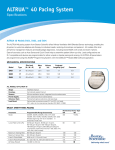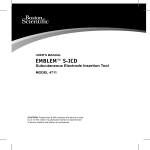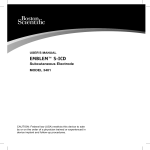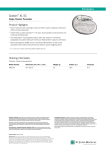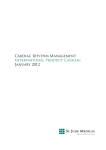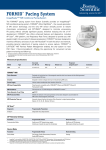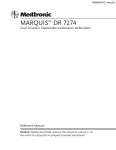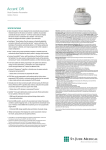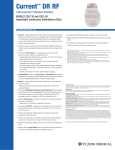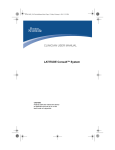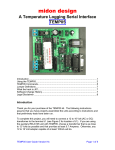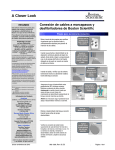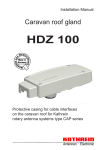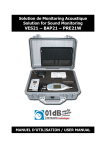Download ALTRUA™ 60 Pacing System
Transcript
ALTRUA™ 60 Pacing System Specifications ALTRUA 60: Models S601, S602, S603, and S606 The ALTRUA 60 pacing system from Boston Scientific offers multiple features that can be specifically programmed to tailor therapy for patient needs: • Multiple AV Delay programming options (fixed, dynamic, and AV Search Hysteresis – now extendable to 400 ms) provide increased flexibility in minimizing unnecessary RV pacing • Minute Ventilation (MV) Blended Sensor is designed to provide a physiologic response for various levels of work in patients of all ages, and restores chronotropic competence1 • Stored Onset EGMs provide a snapshot of the patient’s rhythm before, during, and after a triggered event without sacrificing battery longevity • AutoLifestyle automatically adjusts the blended sensor to ensure appropriate rate response for each individual patient • Automatic Capture enhances patient safety and projected device longevity over the same model2,3 • Ventricular Rate Regulation (VRR) for atrial arrhythmia management All models offer atrial arrhythmia management features and leading-edge diagnostics. Ease-of-use tools such as Auto Sense and Quick Check help to streamline patient follow-up visits. Mechanical Specifications Size (mm) (H W D) Mass (g) Volume (cc) Projected Longevity (yrs)3 Connector SR 42 42 8 23.4 10.0 8.6 IS-1 S602 DR 49 43 8 29.6 12.6 8.8 IS-1 compatible / 3.2 mm S603 DR 44 42 8 25.4 10.8 6.5 IS-1 S606 DR 49 43 8 29.6 12.1 8.8 IS-1 Model Type S601 All models of ALTRUA 60 Shape Modified elliptical Envelope Hermetically sealed titanium Sensors Minute-ventilation sensor, integrated circuit accelerometer Power Supply 2.8-V solid-state lithium-iodine battery Setscrew Style Preinserted captive setscrews and seal plugs Lead Barrel Various lead connectors accept IS-1 and 3.2 mm leads (IS-1 refers to the international standard ISO 5841.3:1992.) *Select Auto to enable Automatic Capture under V Pulse Amplitude parameter options BRADY ARRHYTHMIA PACING Nominal by Device Type ParameterProgrammable Range (Increments) DR SR Mode DDD(R), DDI(R), DOO(R), VDD, VVT, VVI(R), VOO(R), AAT, AAI(R), AOO(R), ODO, OOO, SSI(R), SOO(R), SST, OSO (Modes beginning with O are available in temporary mode only) DDD SSI Lower Rate Limit (LRL) 30–50 ppm (5-ppm), 50–90 ppm (1-ppm), 90–150 ppm (5-ppm) (155–180 ppm [5-ppm], 180–300 ppm [10-ppm], 300–380 ppm [20-ppm] in temporary mode only and only in SSI, SOO, VVI, VOO, AAI, AOO modes) 60 60 Maximum Tracking Rate (MTR) 80–185 ppm (5-ppm) 130 130 Maximum Sensor Rate (MSR) 80–185 ppm (5-ppm) 130 130 A or V Pulse Width 0.05 ms, 0.1–1.0 ms (0.1-ms) 0.4 0.4 A Pulse Amplitude 0.1–3.5 V (0.1-V), 4.0–5.0 V (0.5-V), 6.5 V 3.5 3.5 V Pulse Amplitude Manual Automatic Capture 0.1–3.5 V (0.1-V), 4.0–5.0 V (0.5-V), 6.5 V Auto 3.5 3.5 AV Delay (Paced)1 0–400 ms (10-ms) DYN ■ Sensors Nominal by Device Type ParameterProgrammable Range (Increments) DR SR Minute Ventilation Single chamber Dual chamber OFF, ON, 4➔ON OFF, ON, 4➔ON–A, 4➔ON–V ■ OFF OFF ■ Response Factor Passive, 1–16 (1) 3 3 High Rate Response OFF, 55%, 70%, 85% 70% 70% High Rate Break Point 80–185 ppm (5-ppm) 110 110 ON, OFF, ATR only OFF OFF Activity Threshold V-low, Low, Med-low, Medium, Med-high, High, V-high Med Med Reaction Time 10–50 sec (10-sec) 30 30 Response Factor Passive, 1–16 (1) 8 8 Recovery Time 2–16 minutes (1-minute) 2 2 Time-Dependent Blended Sensor ON, OFF OFF OFF AutoLifestyle ON, OFF, RESET ON ON YES, NO YES YES Accelerometer 4-Minute Fast Walk Within 30 Minutes Rate enhancements Nominal by Device Type ParameterProgrammable Range (Increments) DR SR Hysteresis Offset OFF, -5 to -80 ppm (5-ppm) OFF OFF OFF, 256–4096 cycles (powers of 2) OFF OFF ON, OFF ON ■ Maximum AV Delay 20–400 ms (10-ms) 150 ■ Minimum AV Delay 10–290 ms (10-ms) 80 ■ Sensed AV Offset OFF; -100 to -10 ms (10-ms) -30 ■ AV Search Interval OFF; 32–1024 cycles (powers of 2) OFF ■ 10–100% (10% increments) 30 ■ PVARP (fixed) 150–500 ms (10-ms) 250 ■ Dynamic PVARP ON, OFF ON ■ Maximum PVARP 160–500 ms (10-ms) 250 ■ Minimum PVARP 150–490 ms (10-ms) 240 ■ OFF, 150–500 ms (50-ms) 400 ■ Search Hysteresis Dynamic AV Delay AV Delay Increase PVARP after PVC/PAC Atrial arrhythmia Management Nominal by Device Type ParameterProgrammable Range (Increments) DR SR Ventricular Rate Regulation (VRR) ON, OFF ON OFF 60–150 ppm (5-ppm) 110 110 ON, OFF OFF ■ SBR Detect Time 1–15 minutes (1 minute) 5 ■ SBR Number of Beats 1–8 cycles (1) 4 ■ SBR Therapy Duration 1–15 minutes (1 minute) 10 ■ SBR Therapy Rate Offset 5–40 ppm (5-ppm) 5 ■ SBR MV Offset OFF, 10%–50% (10% increments) OFF ■ Atrial Tachy Response (ATR) ON, OFF ON ■ Trigger Rate 100–200 ppm (5-ppm) 170 ■ Fallback Mode VDI(R), DDI(R) VDI ■ Duration 0, 8–2048 cycles (powers of 2) 8 ■ Fallback Time 0–120 sec (5-sec) 30 ■ ATR Entry Count 1–8 cycles (1) 8 ■ ATR Exit Count 1–8 cycles (1) 8 ■ ATR Lower Rate Limit 30–50 ppm (5-ppm), 50–90 (1-ppm), 90–150 (5-ppm). ATR Lower Rate Limit must be equal to or greater than the permanent Lower Rate Limit. 70 ppm ■ Atrial Flutter Response OFF, 130–230 ppm (10-ppm); DDI(R) mode only: 230 ppm OFF ■ Rate Smoothing programmable for increase and decrease OFF; 3%–24% (3% increments). Separately OFF OFF (VRR) Maximum Pacing Rate Sudden Bradycardia Response (SBR) Sensitivity adjustment Nominal by Device Type ParameterProgrammable Range (Increments) DR SR Atrial Sensitivity Auto, 0.15, 0.25, 0.5, 0.75, 1.0–8.0 mV (0.5-mV), 9.0, 10.0 mV 0.75 ■ Ventricular Sensitivity Auto, 0.25, 0.5, 0.75, 1.0–8.0 mV (0.5-mV), 9.0, 10.0 mV 2.5 2.5 lead configuration Nominal by Device Type ParameterProgrammable Range (Increments) DR SR A or V Lead Configuration Unipolar, Bipolar, Split BI BI refractory Nominal by Device Type ParameterProgrammable Range (Increments) DR SR A Refractory Period 150–500 ms (10-ms) 300 ■ V Refractory Period 200–500 ms (10-ms) 250 250 A Blanking after V Pace 30–200 ms (10-ms) 120 ■ V Blanking after A Pace 30–200 ms (10-ms) 40 ■ other features Nominal by Device Type ParameterProgrammable Range (Increments) DR SR PMT Termination ON, OFF ON ■ Magnet Response OFF, ASYNC, EGM ASYNC ASYNC A or V Lead Safety Switch ON, OFF, RESET OFF OFF Runaway Protection Not Programmable (ppm) 210 210 Chronotropic competence is defined by: Wilkoff BL, Corey J, Blackburn G. A mathematical model of cardiac chronotropic response to exercise. J Electrophysio. 1989;3(3):176–180. Refer to Physician’s System Guide for more information on adaptive-rate therapy. Additional clinical performance was assessed using INSIGNIA Ultra clinical data with the AutoLifestyle feature programmed On. Data on file. 2 Back up pulses are 1.5 V above the last threshold with a minimum of 3.5 V and maximum of 4.5 V. 3 Longevity projections as described in device user manual. Settings: 60 ppm, A=2.5 V, V=1.0 V, 500 ohms, 100% paced, MV Blended Sensor ON, Onset EGMs ON, Automatic Capture ON. 1 Pacing Systems from Boston Scientific CRM Indications Pacemaker indications include: symptomatic paroxysmal or permanent second- or third-degree AV block; symptomatic bilateral bundle branch block; symptomatic paroxysmal or transient sinus node dysfunction with or without associated AV conduction disorders; bradycardia-tachycardia syndrome, to prevent symptomatic bradycardia or some forms of symptomatic tachyarrhythmias; neurovascular (vaso-vagal) syndromes or hypersensitive carotid sinus syndromes. Adaptive-rate pacing is indicated for patients who may benefit from increased pacing rates concurrent with increases in minute ventilation and/or level of physical activity. Pacemakers’ dual-chamber and atrial tracking modes are also indicated for patients who may benefit from maintenance of AV synchrony. Dualchamber modes are specifically indicated for: conduction disorders that require restoration of AV synchrony, including varying degrees of AV block; VVI intolerance (eg, pacemaker syndrome) in the presence of persistent sinus rhythm. Contraindications Pacemakers are contraindicated for the following patients under the circumstances listed: patients with unipolar pacing leads or in MV mode with an implanted ICD because it may cause unwanted delivery or inhibition of ICD therapy; use of the MV sensor in patients with only unipolar leads, because a bipolar lead is required in either the atrium or the ventricle for MV detection; single-chamber atrial pacing in patients with impaired AV nodal conduction; atrial tracking modes for patients with chronic refractory atrial tachyarrhythmias, which might trigger ventricular pacing; dual-chamber and single-chamber atrial pacing in patients with chronic refractory atrial tachyarrhythmias; asynchronous pacing in the presence (or likelihood) of competition between paced and intrinsic rhythms. Warnings Read the product labeling thoroughly before implanting the pulse generator to avoid damage to the system. Such damage can result in patient injury or death Inappropriate sustained high-rate pacing occurred in the PULSAR MAX clinical study in 5 out of 130 patients with MV ON, 4 to 14 days after implant. If sustained high-rate pacing could be of concern, consider programming a reduced Max Sensor Rate or MV to Passive. These programming recommendations are intended to assure that MV calibration is evaluated and, if necessary, recalibrated (4→ON) when the patient and pacing system have stabilized post implant. Continued monitoring of the MV sensor performance should be performed at all follow-up visits until implant stabilization has occurred. Precautions For information on precautions, refer to the following sections of the product labeling: clinical considerations; sterilization, storage and handling; lead evaluation and connection; implantation; programming and pacemaker operation; MV initialization; environmental and medical therapy hazards. Advise patients to avoid sources of electric or magnetic interference (EMI). If the pacemaker inhibits or reverts to asynchronous operation at the programmed pacing rate or at the magnet rate while in the presence of the EMI, moving away from the source or turning it off will usually allow the pulse generator to return to its normal mode of operation. Potential Adverse Events Potential adverse events from implantation of the pacing system include, but are not limited to, the following: allergic/physical/ physiologic reaction, death, erosion/migration, fibrillation or other arrhythmias, lead or accessory breakage (fracture/insulation/lead tip), hematoma/seroma, inappropriate or inability to provide therapy (pacing/sensing), infection, procedure related, and component failure. In rare cases severe complications or device failures can occur. Refer to the product labeling for specific indications, contraindications, warnings/precautions and adverse events. Rx only. (Rev. K) Cardiac Rhythm Management Boston Scientific Corporation 4100 Hamline Avenue North St. Paul, MN 55112-5798 USA Tel: 651.582.4000 Fax: 651.582.4166 Medical Professionals: 1.800.CARDIAC (227.3422) Patients and Families: 1.866.484.3268 www.bostonscientific.com Copyright © 2009 by Boston Scientific Corporation or its affiliates. All rights reserved. C2-180-0409




